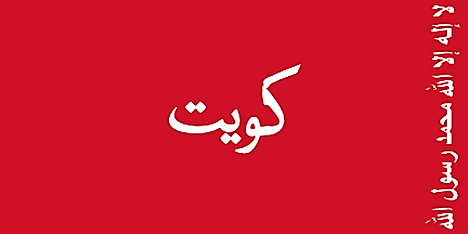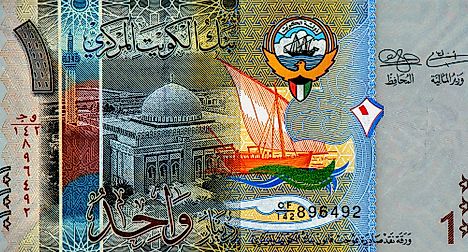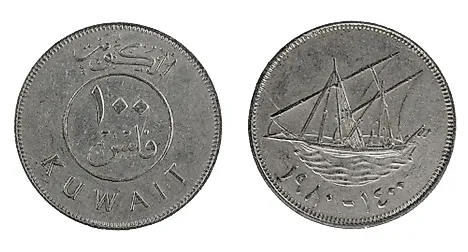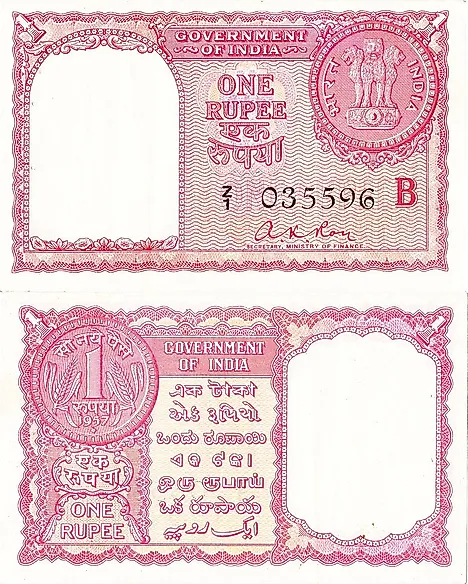Flags, Symbols, & Currencies of Kuwait
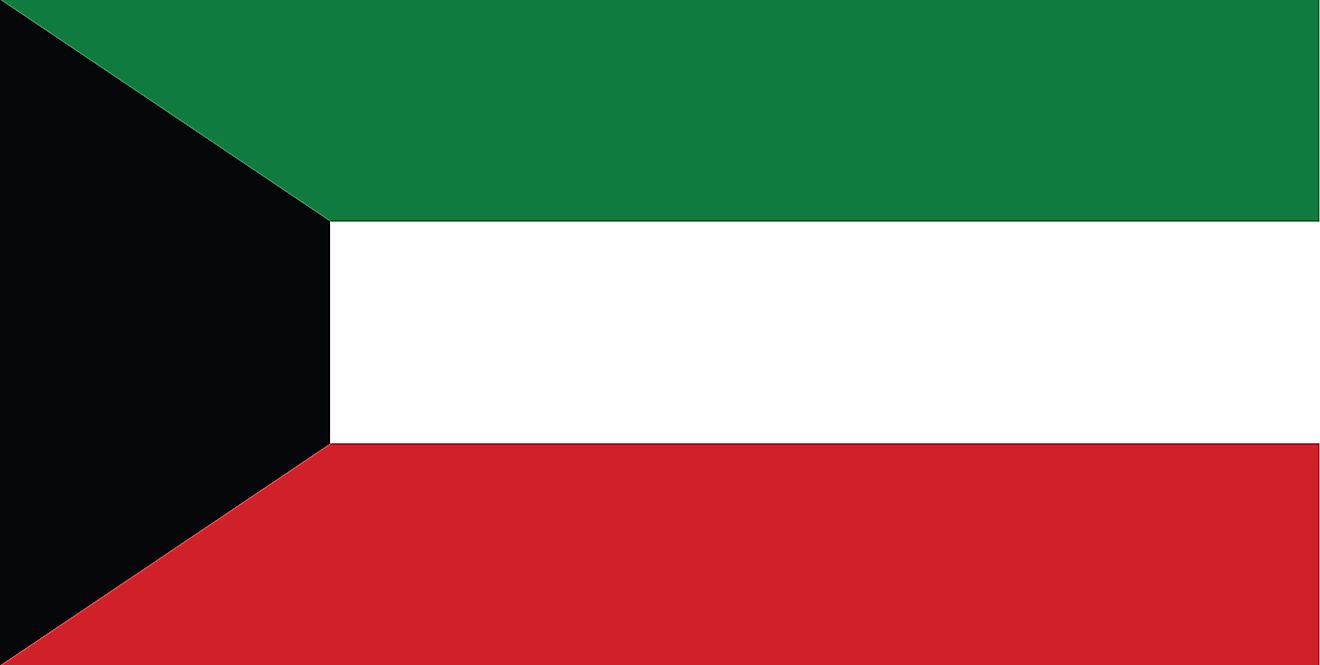
The flag of Kuwait was officially adopted on September 7, 1961. The flag has the Pan-Arab colors of white, red, black, and green. These colors are found in the flags of most Arabic nations. Each of the colors on the national flag of Kuwait has a significant message for the people of Kuwait. The flag consists of a black trapezoid on the hoist side and three equal horizontal bands of Green (top), white, and red. The flag has a width to length ratio of 1:2.
The black color on the left side of the flag symbolizes victory over the nation’s rivals. The green stripe at the top symbolizes Kuwait's beautiful plantations and fertile land. The white stripe in the middle signifies peace that the country always strive for. Lastly, the red stripe at the bottom stands for the blood shed during the struggle for independence from the UK. The rules for flying Kuwait’s national flag require that the green stripe stays at the top when hoisted horizontally and the red stripe stays on the left when it is hoisted vertically.
Kuwait’s national flag is an important symbol of national unity for the citizens of Kuwait. The flag is flown during important events in the country such as Independence Day celebrations, sporting events, and in times of national mourning. In 2004, the flag of Kuwait was used to design the largest kite in the world. The kite with the colors of Kuwait’s flag was 1,019 square meters in size.
History of the Flag
Kuwait obtained its first national flag in the late 19th century. The flag was plain red with no inscriptions or symbols, and it was borrowed from the flags of neighboring Persian Gulf nations. In 1899, Kuwait modified its flag to include a crescent, a star, and the inscription "Kuwait" in Arabic. The symbols and writing were centrally placed on the flag. In 1909, Kuwait changed its flag. The Arabic inscriptions ‘Kuwait’ was moved to the top right corner, and the symbols stayed at the center of the flag but were enlarged. Six years later in 1915, Kuwait modified its flag once again. It removed the two symbols of star and crescent from its flag and centered the Arabic writing. The flag retained its design of white inscriptions on a red background until 1956. In 1956, Kuwait added the inscriptions "There is no God but Allah" on the left side of the flag. In 1961, the Arabic nation once again changed its flag to the current design of green, white, and red stripes.
Symbols of Kuwait
National Coat of Arms of Kuwait
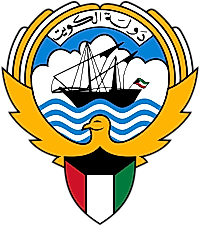
Kuwait's coat of arms (considered an emblem) was adopted in 1962, and is composed of a golden falcon bearing a shield depicting the national flag. Within the wings of the falcon is a ship sailing over water with Kuwait's full name written above in Arabic. The sailing ship is a symbol of Kuwait's maritime activities. The falcon is a symbol of Banu Quraishi line, an Arab tribe which Prophet Muhammad belonged.
National Anthem
- Anthem Title: an-Nashīd al-Waṭani (National Anthem)
- Music composer: ʾIbrāhīm al-Ṣūla
- Lyricist: ʾAḥmad Mishārī al-ʿAdwānī
- Date of Adoption: February 25, 1978
Kuwaiti national anthem is known as "an-Nashīd al-Waṭani" (National Anthem) and was adopted on February 25, 1978, as a replacement for the old anthem known as Amiri Salute. The anthem's lyrics were written by ʾAḥmad Mishārī al-ʿAdwānī and set to music by ʾIbrāhīm al-Ṣūla. If features three verses and a chorus, repeated after every verse.
an-Nashīd al-Waṭani
جوقة:
وطني الكويت سلمت للمجد
وعلى جبينك طالع السعد
وطني الكويت وطني الكويت
وطني الكويت سلمت للمجد
١
يا مهد آباءالأولو كتبوا
سفرالخلود فنادت الشهب
الله أكبر إنهم عرب
طلعت كواكب جنة الخلد
جوقة
۲
بوركت يا وطني الكويت لنا
سكنا وعشت على المدى وطنا
يفديك حر في حماك بنى
صرح الحياة بأكرم الأيدي
جوقة
٣
نحميك يا وطني وشاهدنا
شرع الهدى والحق رائدنا
وأميرنا للعز قائدنا
رب الحمية صادق الوعد
جوقة
National Anthem
Kuwait, my country, may you be safe and glorious!
May you always enjoy good fortune!
You are the cradle of my ancestors,
Who put down its memory.
With everlasting symmetry, showing all eternity,
Those Arabs were heavenly,
Kuwait, my country,
May you be safe and glorious!
May you always enjoy good fortune.
Blessed be my Country a homeland for harmony,
Warded by true sentry giving their soils aptly,
Building high its history, Kuwait,
My country, we're for you my Country,
Led by faith and loyalty,
With its Amir equally,
Fencing us all fairly, with warm love and verity,
Kuwait, my country,
May you be safe and glorious.
May you always enjoy good fortune!
The Currency of Kuwait is the Kuwaiti Dinar
The official currency of Kuwait is the Kuwaiti dinar, introduced in 1960 as a replacement for the Gulf Rupee. It is one of the highest-valued currency unit per face value in the world. The dinar is subdivided into 1000 fils and comes in banknotes and coins of different denominations.
Coins and Banknotes
Kuwaiti dinar coins were introduced in 1961 and are in the denominations of 5, 10, 20, 50, and 100 fils. All the coins have similar features on both reverse and observe sides. The observe side features a dhaw ship and year of minting in Islamic and Arabic while the reverse side contains a circle with the coin's value and name "KUWAIT" in both English and Arabic.
There are six series of printed banknotes. The first series was established after the declaration of the Kuwaiti monetary law in 1960. This law was used to launch the Kuwait currency board. This series existed between 1961 and 1982, and it consisted of the following denomination: ¼, ½, 1, 5, 10, and 20 dinars. The second series commenced just after the foundation of the central bank of Kuwait in 1969. The 10, ¼, and ½ dinar notes were introduced in November 1970 while the 1 and 5-dinar notes were pioneered in 1971. A third series was launched in February 1980 after the late Emir Jaber al-Ahmad al-Jaber al-Sabah came to power. Its domination consisted of ¼, ½, 1, 5, and 10 dinars. Later, in 1986, a 20 dinar note was brought to existence.
A significant amount of these banknotes were stolen by the Iraqi army, and were spotted on the international numismatic market. After restoration of peace from the attacking Iranians, a fourth series was issued on March 24, 1991, with the main aim of replacing the past series as fast as possible, and ensuring the countries quick economic rejuvenation. This fourth series was issued as legal tender before being rendered invalid in February 1995.
The fifth series of Kuwait banknotes was launched on April 3, 1994. Very high technological intelligence, now standard, was incorporated in the making of the banknotes. The denomination of the fourth series was the same as those of the fourth series. The sixth series banknotes were issued from June 29, 2014. Some of these notes are designed to be rough in order to be interpretable by the blind through touching.
Historical Currencies of Kuwait
Kuwait was using the Gulf rupee, which was equivalent to the Indian rupee. The Indian rupee had the same value with the one sterling pound. Kuwait dinar was launched in 1960 substituting the Indian rupee. The Kuwait dinar was then replaced during its invasion by the Iranians as substantial amount of banknotes were stolen by the attacking military groups. After the peace re-establishment and liberation to freedom, the Kuwait dinner was brought back as the country’s currency, with the previous notes, along with the stolen ones, being demonetized.
